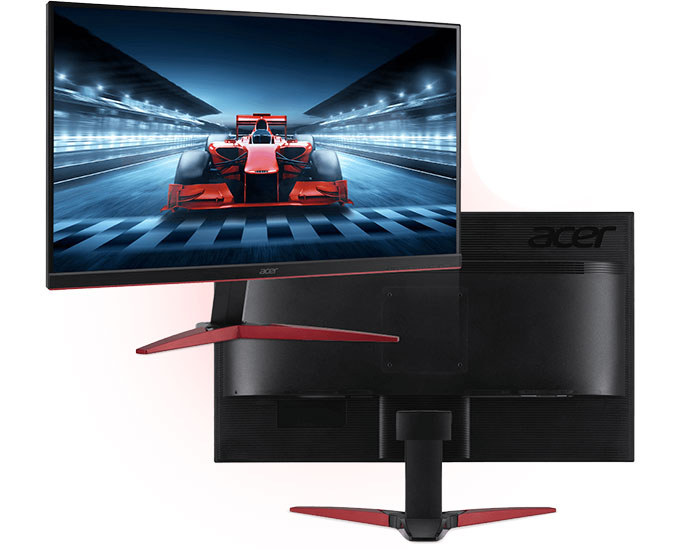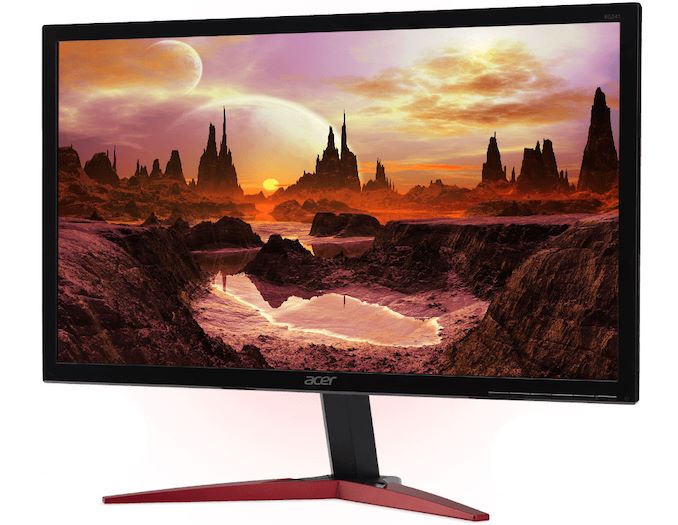Acer Unveils KG1 Displays with Sub-1ms Response Time
by Anton Shilov on November 21, 2018 9:30 AM EST
Acer Japan has introduced a lineup of gaming displays featuring a response time below 1 ms. The Acer KG1 family includes seven models featuring a 23.6, 24,5 and 27-inch diagonal and set to target different price segments.
The Acer KG1 monitors rely on non-glossy Full-HD (1920x1080) TN panels featuring between 0.5 ms and 0.8 ms GtG response times, depending on exact SKU. These are blistering response times, and if the specifications listed here are accurate – and with the grain of salt that monitor response time specifications have historically been overestimated – then we're talking about panels can finish a grey-to-grey transition in as little as one-fifth the time of an actual frame update.
Meanwihle, since we are dealing with TN technology, the monitors feature a rather standard 250 – 400 nits brightness, a 1000:1 contrast ratio, as well as 170°/160° horizontal/vertical viewing angles. Acer is listing an sRGB color space for these monitors, though as they're clearly all-in on response times, we'll have to wait and see just how much of that color space they can actually cover.
Being aimed primarily at gamers, Acer’s KG1-series displays support AMD’s FreeSync dynamic refresh rate technology as well as various gaming-oriented functions, such as AcerAimPoint crosshair, an FPS counter, BlackBoost technology that makes faced-paced scenes look sharper, and so on.
When it comes to inputs, the KG1 displays have a rather standard set of connectors, including DisplayPort 1.2 and HDMI 1.4/2.0 headers. Meanwhile, some models are also outfitted with legacy D-Sub and DVI-D connectors.
Moving on to pricing of the KG1 monitors. Being unique, Acer’s new displays with a sub-1 ms response time carry a premium price tag for Full-HD LCDs. The cheapest KG251QGbmiix model costs ¥19,000 ($169) without VAT, whereas the most expensive KG271Fbmiipx SKU is priced at ¥50,000 ($444) without taxes.
Acer Japan has not announced when the KG1 displays will be available on other markets, though it is logical to assume that the company will try to capitalize on its exclusive panels.
| Specifications of Acer's KG1 Gaming Displays | ||||||||
| KG241QA | KG251QG | KG251QH | KG251QI | KG271D | KG271E | KG271F | ||
| Panel | 23.6" TN | 24.5" TN | 27" TN | |||||
| Native Resolution | 1920 × 1080 | |||||||
| Maximum Refresh Rate | 144 Hz | 75 Hz | 144 Hz | 240 Hz | 75 Hz | 144 Hz | 240 Hz | |
| Dynamic Refresh | Tech | AMD FreeSync (LFC is not confirmed) | ||||||
| Range | ? | ? | ? | ? | ? | ? | ? | |
| Brightness (cd/m²) | 300 | 250 | 400 | 300 | 400 | |||
| Contrast | 1000:1 | |||||||
| Viewing Angles | 170°/160° horizontal/vertical | |||||||
| Response Time | 0.7 ms | 0.7 ms | 0.6 ms | 0.5 ms | 0.6 ms | 0.8 ms | ||
| Pixel Pitch | 0.27 mm² | 0.28 mm² | 0.31 mm² | |||||
| Pixel Density | 93 PPI | 90 PPI | 82 PPI | |||||
| Color Gamut Support | sRGB | |||||||
| Inputs | 1×DP 1.2 1×HDMI 1.4 |
1×D-Sub 1×HDMI 1.4 |
1×DVI-D 1×DP 1.2 1×HDMI 1.4 |
1×DP 1.2 1×HDMI 2.0 1×HDMI 1.4 |
1×D-Sub 2×HDMI 1.4 |
1×DVI-D 1×DP 1.2 1×HDMI 1.4 |
1×DP 1.2 2×HDMI 2.0 |
|
| Audio | - | 2×2W speakers | ||||||
| VESA Mounts | 100 × 100 mm | |||||||
| Additional Information | Link | Link | Link | Link | Link | Link | Link | |
| Price | $240 | $169 | $266 | $382 | $213 | $328 | $444 | |
Related Reading:
- AOC to Launch Curved QHD Displays with 0.5 ms Response Time in 2018
- Acer XZ1-Series Curved Gaming Displays: WQHD, 144 Hz, FreeSync, HDR10
- Acer Announces Nitro XV273K Monitor: 4Kp144, DisplayHDR 400, FreeSync
- Acer Unveils Predator XB273K 4Kp144 DisplayHDR 400 Gaming LCD
Sources: Acer Japan, Hermitage Akihabara











12 Comments
View All Comments
imaheadcase - Wednesday, November 21, 2018 - link
Hey look another hundred monitors that is the exact same thing as years past rebranded. Even kept the ugly design.deil - Wednesday, November 21, 2018 - link
So many numbers so confusingly similar to last gen that I bought dellOpencg - Wednesday, November 21, 2018 - link
Actually these could be much better if you care about response time. Just fyi the best 1ms monitors achive an average of 4ms response. Many are much worse. This is typically rated by the point at which 90% of the transition is achieved for each starting and ending brightness level.Meaning at 240hz most of each frame is displayed as a transition between colors. Meaning its blured significantly.
Depending on input lag and blur reduction modes these could be even better still. So yeah these are actually better than anything that has ever been for sale in terms of response time. You should shut up with your whining.
Diji1 - Thursday, November 22, 2018 - link
Last I checked ULMB cannot go higher than 144Hz - maybe that's changed on more recent models of monitor like this though.I prefer using 144Hz ULMB over 240Hz so what you say makes sense.
Opencg - Thursday, November 22, 2018 - link
Ulmb is an nvidia branded blur reduction mode. While other blur reduction modes sometimes let you go above 144hz they can have increased crosstalk (combining the colors of two frames) and usually require user calibration to be optimal. ULMB is pre configured and usually gives a great experience right out of the box. These are free sync so they may have 240hz blur reduction modes and the fast response time would give reduction in crosstalk. But you need to push 240fps to really get an optimal experience this way.The best thing in my opinion would be a variable refresh rate blur reduction mode but it would likely be expensive or problematic.
mdrejhon - Tuesday, December 25, 2018 - link
Very impressive Opencg -- you're correct, and you must have learned the information from Blur Busters. (I'm the Founder of Blur Busters here).0.6ms GtG will greatly reduce strobe crosstalk and may be possible to do 240Hz blur reduction with very minimal user calibration. It's essentially the art of cramming GtG into the VBI, and hiding the GtG in the dark period between strobe backlight flashes. Briefer refresh cycles (1/240sec = 4ms) means very little time to hide GtG between refresh cycles made visible to eye.
mdrejhon - Tuesday, December 25, 2018 - link
1ms response is measured industry standard GtG10% thru GtG90% transition. The full GtG100% will often need a full refresh cycle (or two) to fully transition to final color. Which indeed is 4ms in the case of 240Hz monitors (1/240sec = 4ms). However, the majority (80% of the curve) of response time is completed in that 1ms, ignoring the beginning and end of the GtG curve. Very well-tuned overdrive can mean that the majority of the photons from pixel response is pushed very early in the curve, e.g. the first 1-2ms. Players can begin reacting at the stimulus of roughly GtG10% so that's often a good measurement baseline, though different lag tests measure lag to GtG50% or GtG100%, depending on the test-website's goal. In high speed video, it's like the new refresh cycle becoming roughly 10% visible (alphablend like transition effect from old refresh cycle to new refresh cycle) -- humans don't necessarily need GtG100% to begin the reaction-time stimulus.godrilla - Wednesday, November 21, 2018 - link
At least they they broke away from the rgb lighting on last last gen technology sold at todays premium price. lol.Dragonstongue - Wednesday, November 21, 2018 - link
AH HA HA HA..RGB is so overdone so many things use it and the product generally tends to "suffer" because they prioritize RGB at the cost of everything else to hit a price "target" same goes with the crud load of cases these days that are all about "closed in" glass type to show off the RGB "who cares about cooling" ^.^mdrejhon - Thursday, November 22, 2018 - link
0.5ms pixel response times become more important at 240Hz and even 480Hz+ where pixel response time is a significant fraction of a refresh cycle.In addition, 0.5ms can help improve strobe-based motion blur reduction (reduced strobe artifacts) by being able to hiding even more of LCD GtG in the VBI (blanking interval between refresh cycles).
It will also help bring strobeless ULMB -- motion blur reduction via ultra high refresh rates in future monitors (480Hz+). A good read is the Blur Busters Amazing Journey to Future 1000Hz Monitors, located at www.blurbusters.com/1000hz-journey